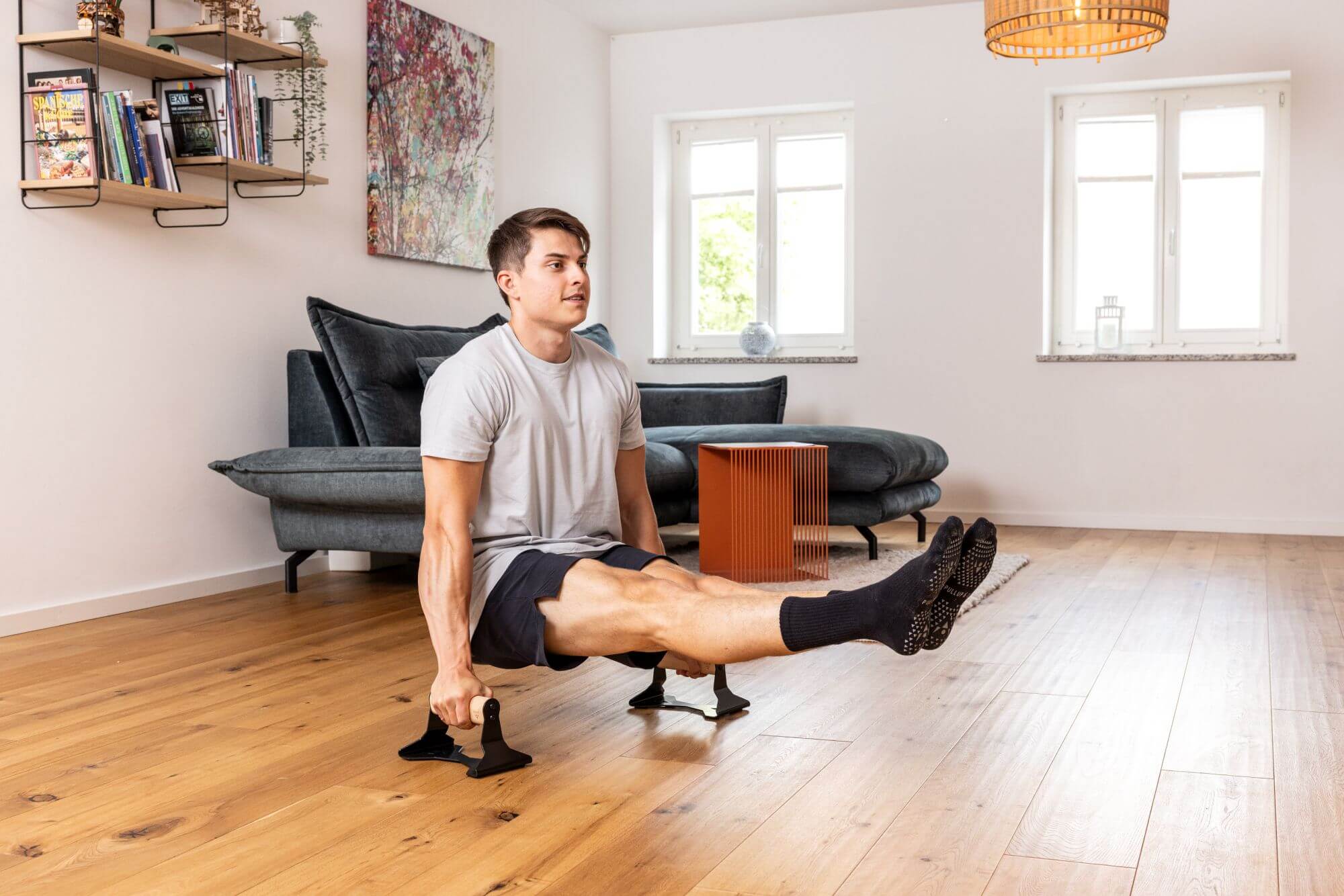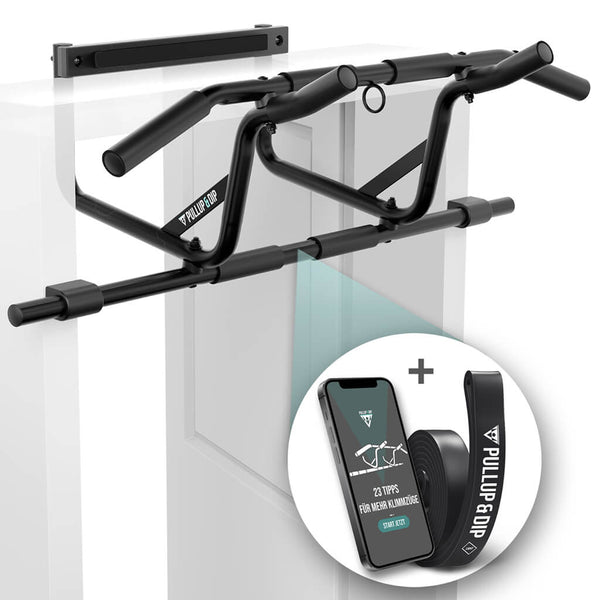
Doorway Pull-Up Bar - For The Door Frame - Includes Pull-Up Band
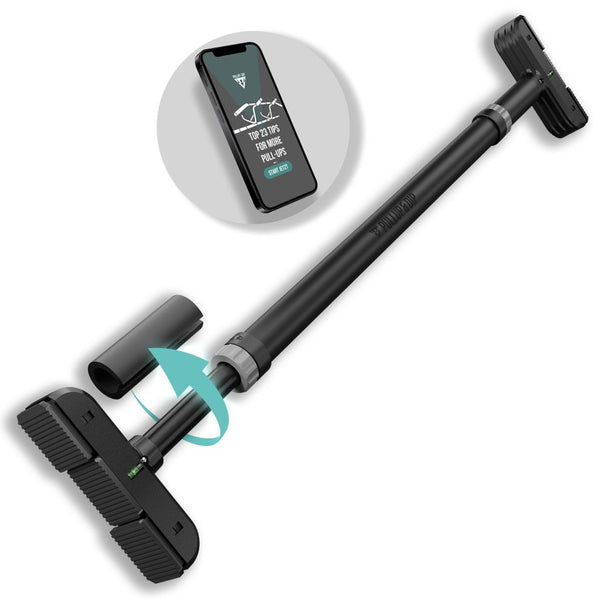
Telescopic Door Pull-up Bar Without Screws
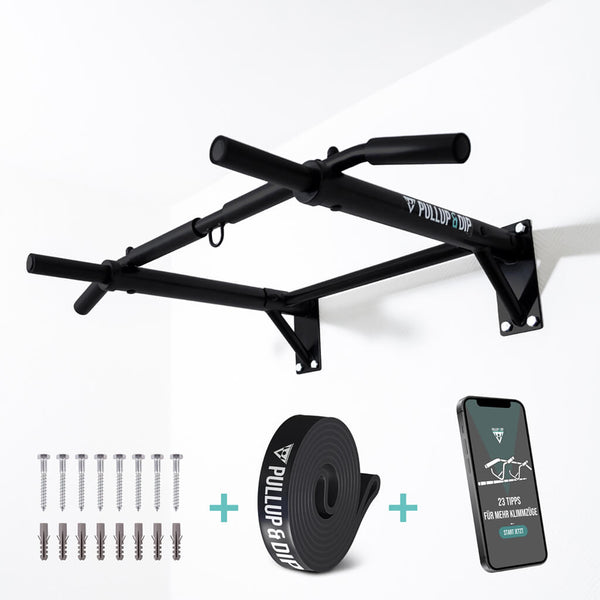
Wall Mounted Pull-Up Bar incl. Pull-Up Band And Screws
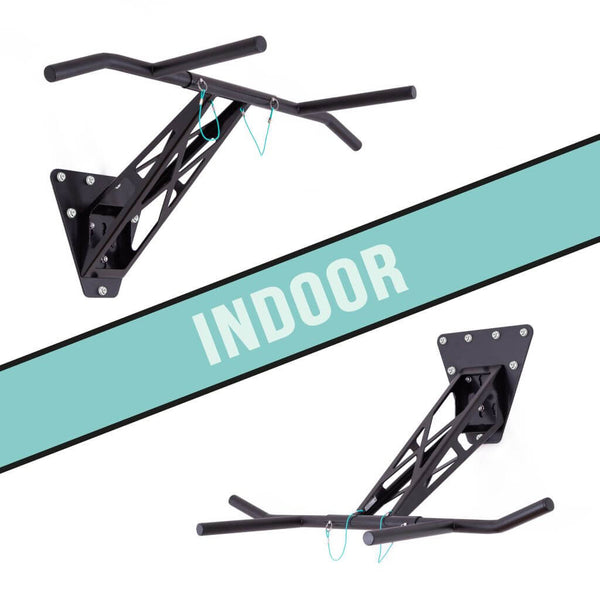
Pull-Up and Dip Bar - Mount On Indoor & Outdoor Wall, Worldwide Unique
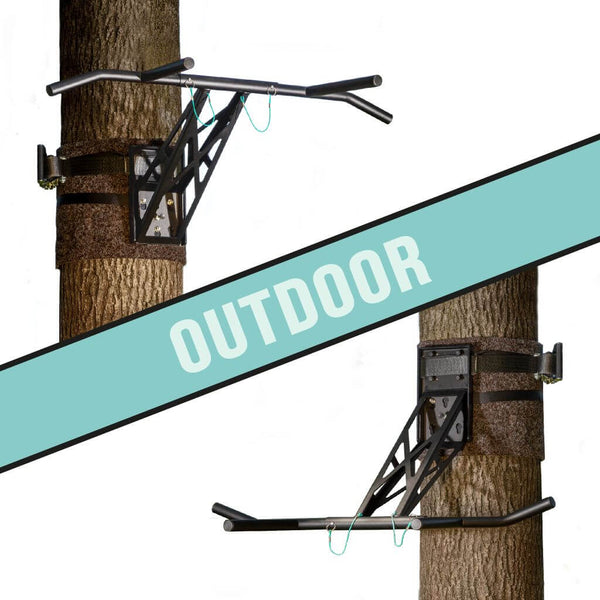
Mobile Outdoor Pull-Up and Dip Bar for Backyard or Park, Portable Gym For Over 35 Exercises
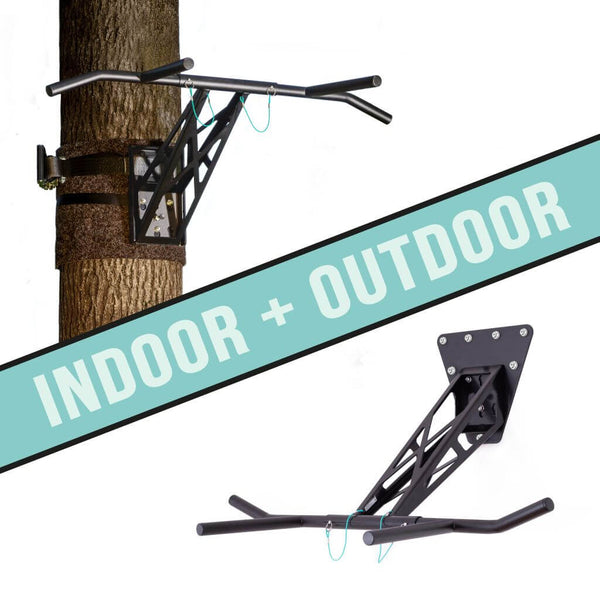
Mobile Pull-Up And Dip Bar - Indoor And Outdoor, Portable Gym For 35 Exercises
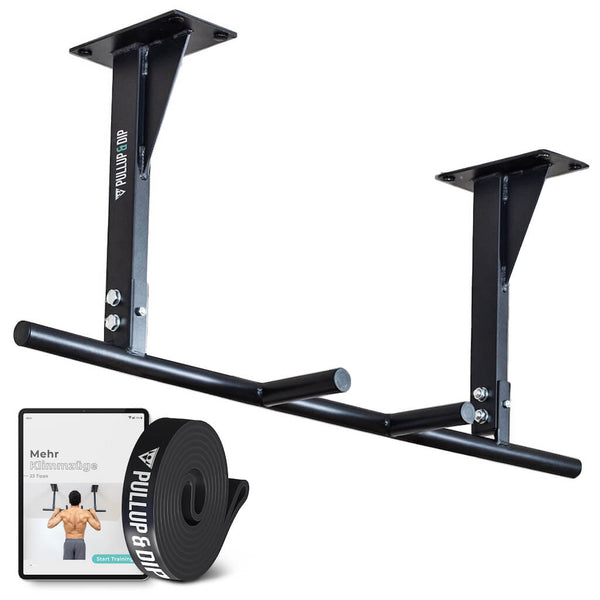
Pull-up bar ceiling incl. pull-up band and screws

Pull-up bar for Wall Mounting Above the Door Frame
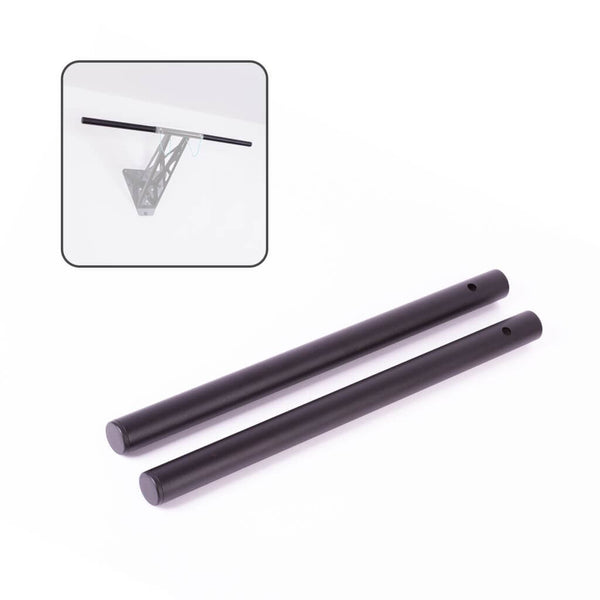
Straight Muscle-Up And Pull-Up Bar, Accessory For Pullup & Dip Bar
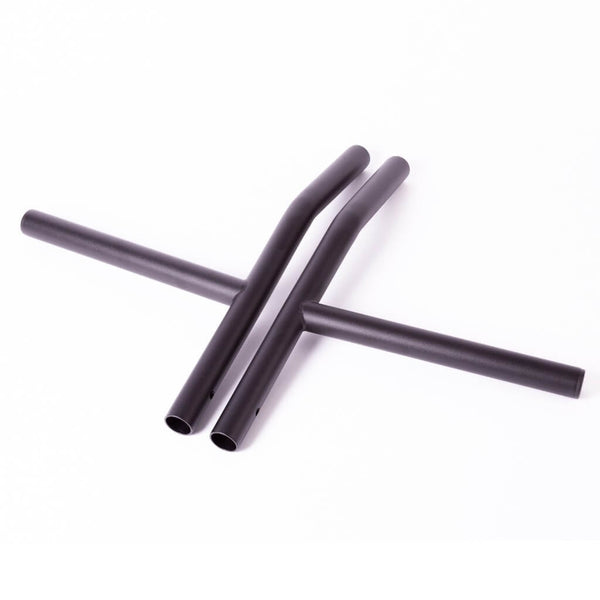
Multi Grip Pull-up Bar and Dip Bar (Steel, Black)
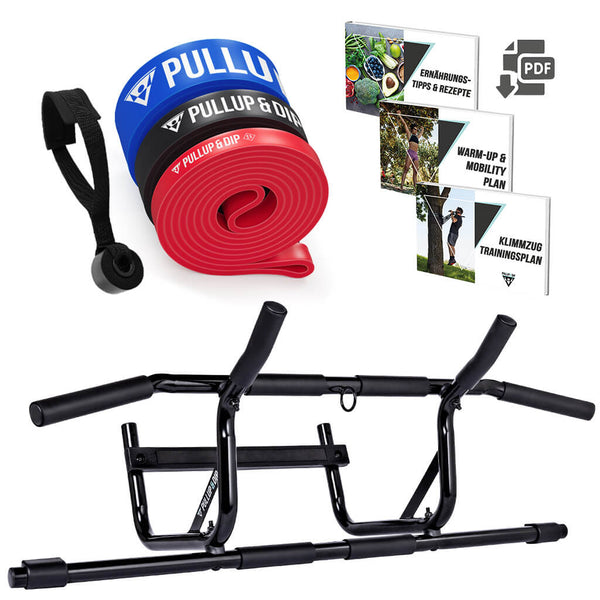
Pull-up Beginner Set: Doorway Pull-up Bar, Pull-up Bands Set of 3 & Guide Bundle in English
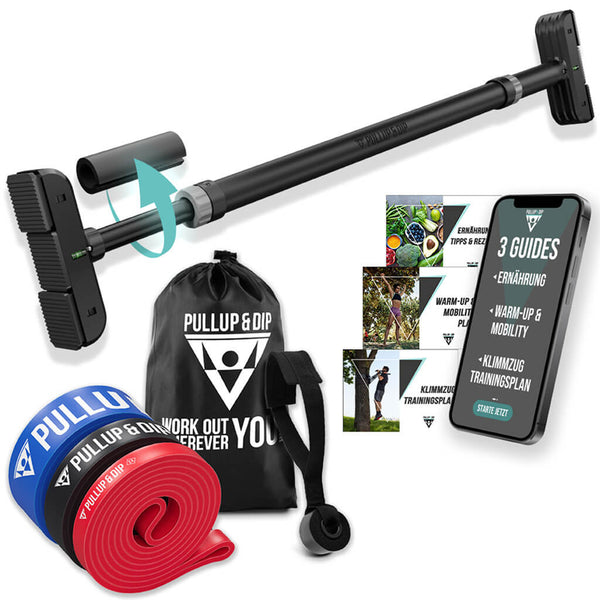
Door Pull-up Bar Bundle with 3 Pull-up Bands and 3 Training Guides (English)
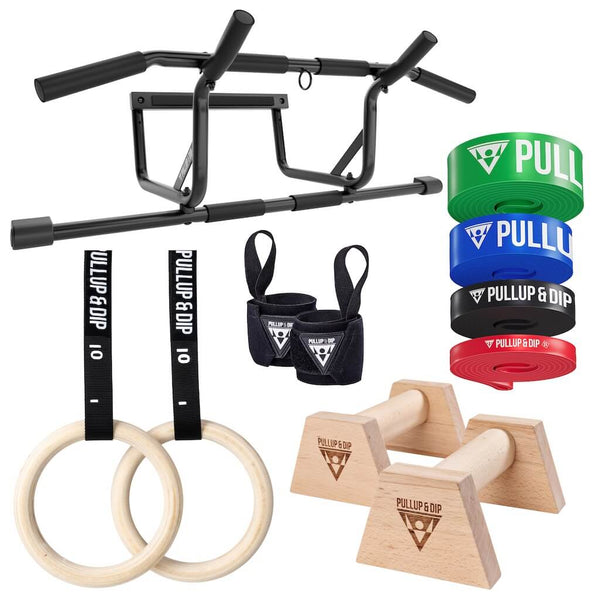
Calisthenics Essentials Set - carefree bundle for beginners
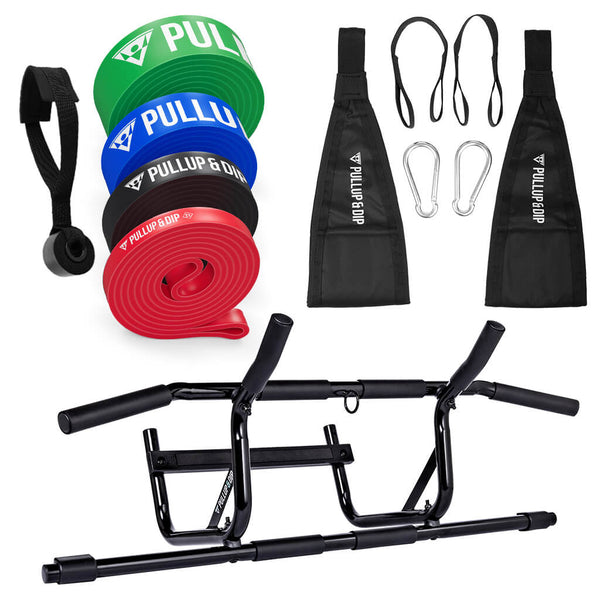
Pull-up Bar Set: Door Pull-up Bar + Pull-up Straps Set of 4 + Ab Straps
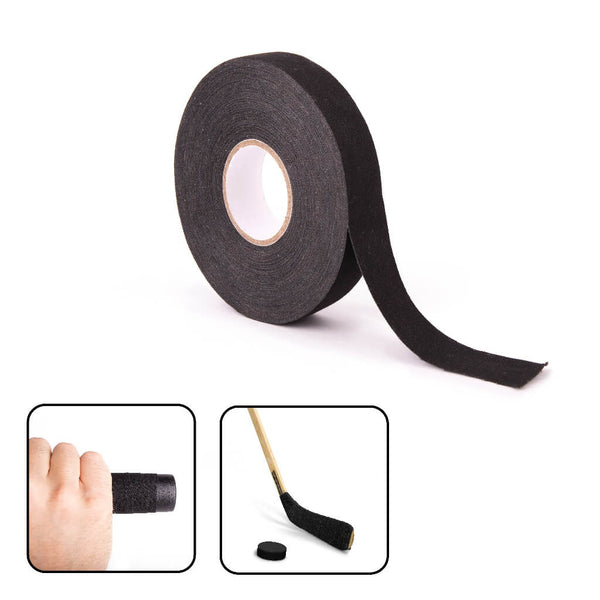
Grip Sports Tape for Pull-up Bar, Anti-Slip Tape For Golf, Tennis and Ice Hockey Sticks
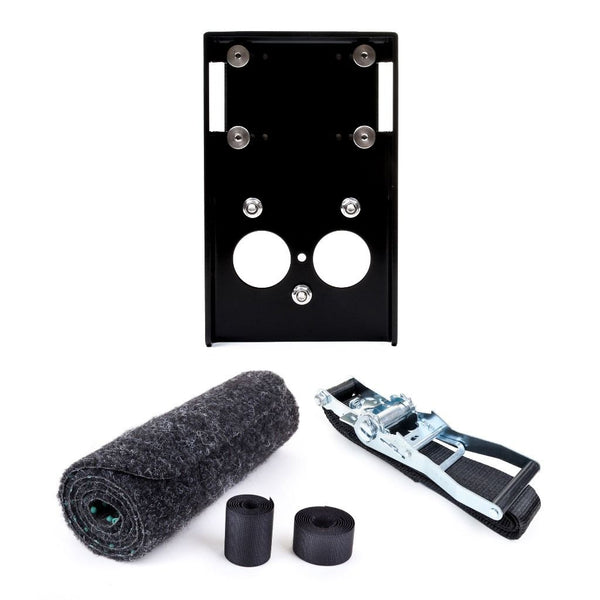
Outdoor installation package for Pullup & Dip bar, black steel version
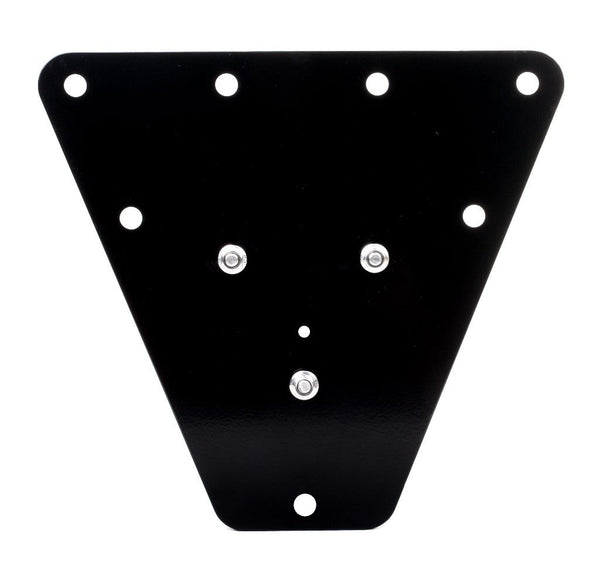
Wall adapter for Pullup & Dip bar, black steel version
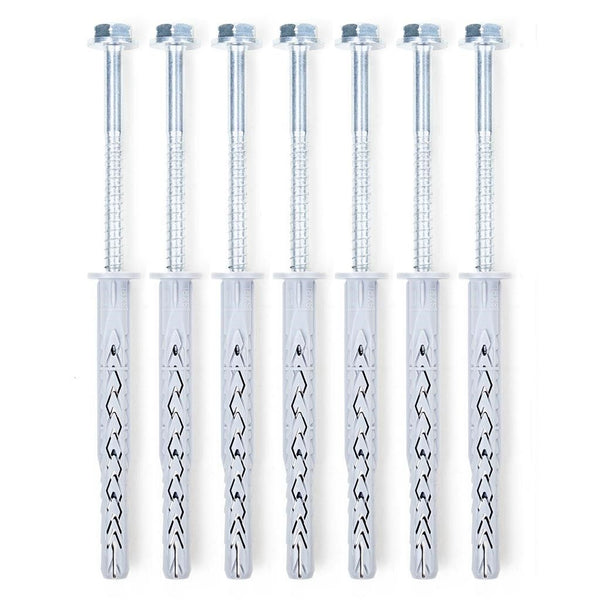
7x pull-up bar screws / fischer long shaft dowel SXRL-FUS 10 x 80 mm
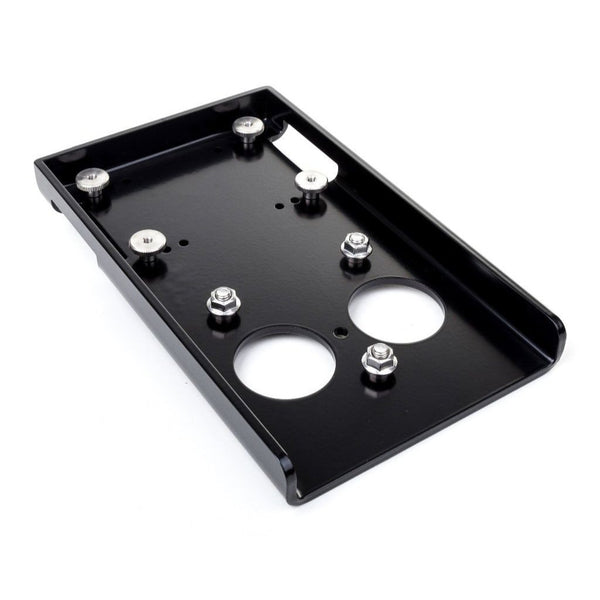
Outdoor adapter for the outdoor installation of Pullup & Dip bar, black steel version
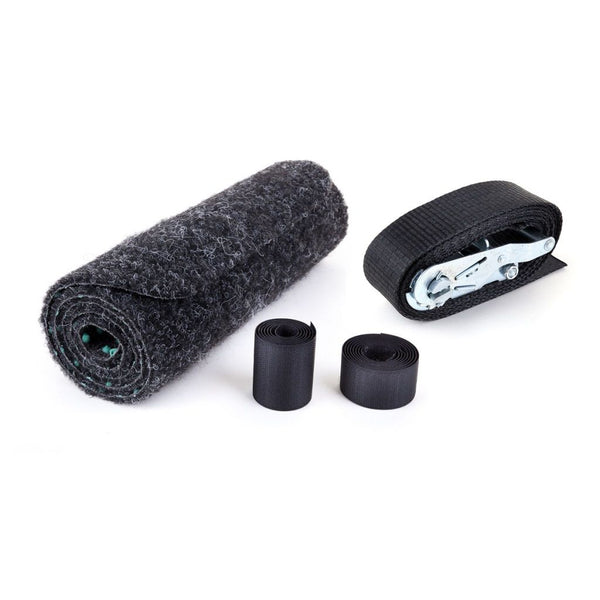
Protection mat and tension belt for outdoor installation of Pullup & Dip bar on tree/post
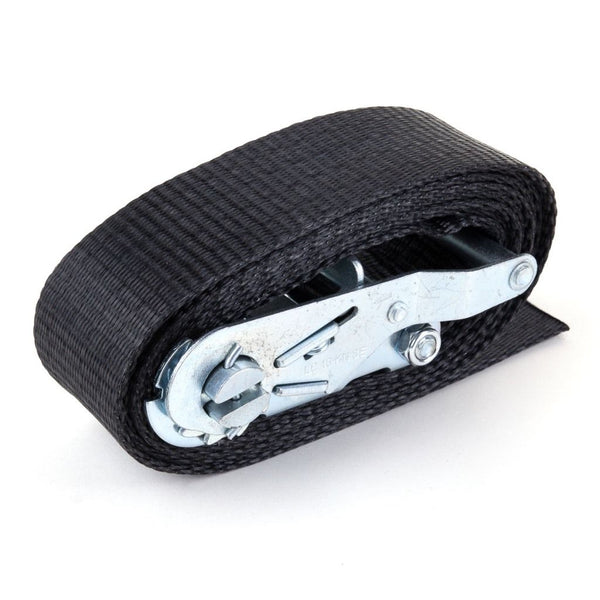
Tension belt 2.5m for outdoor installation of Pullup & Dip bar
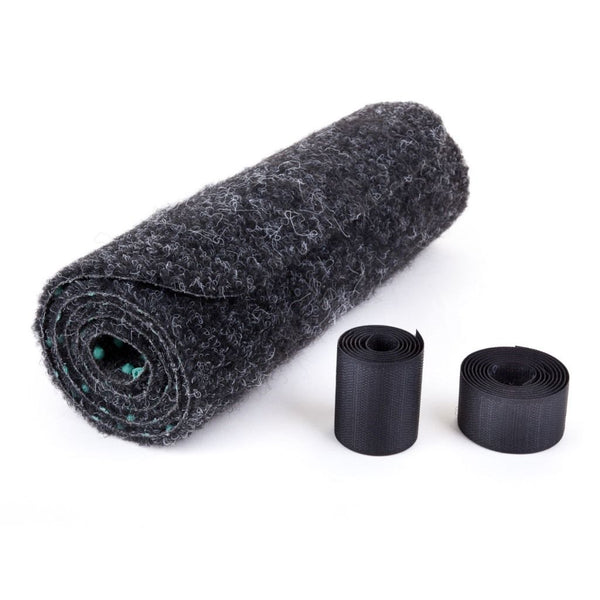
Tree protection incl. velcro fasteners for outdoor installation of Pullup & Dip bar on tree/post

"The Pull-Up Bible" Hardcopy Book (German)
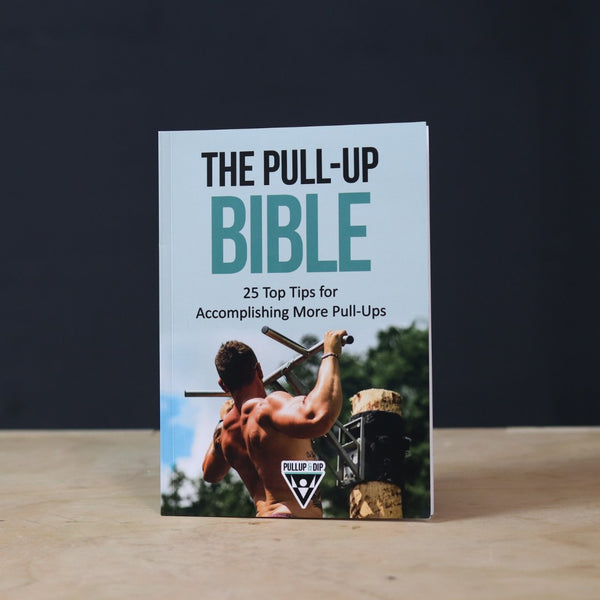
"The Pull-Up Bible" Hardcopy Book (English)
Pull-up bars are an extremely popular apparatus when it comes to strength training, allowing you to do one of the most important exercises for your upper back – pull-ups. However, if the right pull-up bars are chosen, several different pull-up variations can be explored – making it possible for you to work on several different muscle groups, for a comprehensive effect. What’s more, they can be used to work the abdominals and for doing dips.
Pull-up bars provide huge potential for strength training into a single piece of equipment, as well as adding great value to other sports when working out on a pull-up bar. For example, swimmers and rowers depend on a well trained, strong back. With this article, we hope to help you take a closer look at the vast possibilities with pull-up bars.
What are the features of good pull-up bars?
All pull-up bars should include the following:
- Material
- Grips:Number & Material
- Safety
Material

Often, the longest-lived devices are made from steel, adding durability and longevity to a product. For long-term use, choosing a pull-up bar made form steel or stainless steel, gives reassurance that you are investing in quality and value for money.
Grips: Number & Material

The more experience you have, or plan to have in strength training, the more grip variations you are going to need. These variations allow you to work out your back and biceps more effectively, while having positive effect on muscle growth – providing you workout consistently! Look for the following two points:
- The grips should be far enough apart so you aren’t hindered when pulling up or down during the exercise.
- Ideally, the grips should be of roughened stainless steel for a non-slip workout. Alternatively, the grips may have special padding or covers so grip remains firm – even if your hands are sweaty!
Safety

Both yourself and the manufacturer are responsible for safety. Ideally, the manufacturer should supply a standardised, tested pull-up bar ensuring the safety of its user. Thereafter, it is your responsibility to ensure the place in which the pull-up bar is mounted can bear the weight involved. Avoid using particularly thin walls, and walls that have been damaged by mould, damp or any other influences.
Factors to consider when buying pull-up bars
You must take the following into consideration:
- Mounting
- Maximum body weight
- Dimensions
- The weight of the bars
Mounting

The mounting depends on where you want to attach the pull-up bars – walls, ceilings or doors are most common. The possibilities are limited depending on your chosen location. However, if space is limited, our mobile pull-up bars or pull-up bars for the door would be what we suggest.
Choose a place where the pull-up bars blend harmoniously into the overall picture.
Maximum body weight

The maximum body weight isn’t usually a problem for bars that are bolted to the wall or ceiling – although generally, you should weigh less than 300 kilograms. If the bars are not bolted into place, the general rule is a bodyweight of 100 kilograms or less. However, you do need to consider the movements that are executed during pull-ups which exert additional forces on the bars.
Dimensions
Pull-up bars are available in a wide range of dimensions. For example, pull-up bars for the door can be conveniently adjusted to fit the door frame. However, it usually follows that these pull-up bars are limited in terms of width. For a more varied width, pull-up bars need to be chosen that fit to the wall or ceiling – ensuring that they match your environment in terms of space.
We suggest dusting off your tape measure or guestimating in order to choose the most suitable model for you.
Weight of the bars
Weight is relevant for two reasons: on one hand the wall must be able to withstand your weight, the weight of the bars and the forces generated by the movements. On the other hand, you might want your pull-up bars to be mobile. If you want to use them outdoors, or on-the-go, it would be best to get the lightest set of pull-up bars possible.
Remember: an adequate load-bearing capacity takes precedence over the weight, especially with mobile pull-up bars. Broken pull-up bars that cause you to fall and injure yourself are no use to anyone.
Pull-up bars for the wall, door, ceiling and garden
Going into the details of all the different types of pull-up bars would go beyond the scope of this article, therefore, we have drawn up the following table to give you a compact overview of the designs, their characteristics and their advantages and disadvantages.
Type of bars |
Properties |
Advantages |
Disadvantages |
Wall Attachment |
Is mounted on the wall, and offers maximum freedom of movement |
• High degree of safety • Many grip variations • Robust & able to bear heavy weights • Lots of freedom of movement |
• Takes up lots of space • Mounting takes time |
Ceiling Attachment |
Is mounted on the ceiling, and offers slightly limited freedom of movement |
• High safety standard • Many grips at various widths • High level of stability and load-bearing capacity • Plenty of freedom of movement, but less than the wall-mounted models |
• Mounting takes time • Particularly difficult overhead mounting • A potential danger to the ceiling in old buildings |
Pull-up bars for the door |
Is mounted on the door frame and is very lightweight |
• Lightweight design ensures easy transport • Cheap • Saves space • Does not damage the door frame |
• Limited load-bearing capacity & limited freedom of movement • Mounting height is low • Low degree of safety |
The unique pull-up bars from Pullup & Dip prove that a fusion of several designs is possible. Therefore, in our range, we have pull-up bars for the garden and other outdoor areas. These bars can also be attached to trees and poles outdoors for mobile use, or they can be mounted on the wall at home. By simply turning it over, the pull-up bar becomes a dip bar. Ingenious!
If you want more information about the different types of pull-up bars, the following article will give you all the information you need about buying pull-up bars.
How do I manage more pull-ups?

Let’s move on to some practical issues. Since we have your attention and you’re feeling motivated to find out more about pull-up bars, we can assume you have already tried some exercises in this direction – or intend to do so! Take a look at our Top 9 Tips!
Tip #1: Variation of your grip
If you vary your grip, you give different muscle groups a varied workout and shift the centre of the load. This prevents stagnation of your progress.
Tip #2: Adapt your speed of movement
Ideally, the speed of lowering yourself is three times faster than the speed of pulling up. This ensures that the muscles remain tensed for longer, giving a better workout effect.
Tip #3: Switch between chest and neck
Alternate between pulling yourself up to chest-height and neck-height. This puts more strain on the joints, but achieves more variety – which provides good stimuli for muscle growth.
Tip #4: Focus on strength endurance
Generally speaking, strength endurance involves doing more than twelve repetitions at a stretch, per set. By increasing the number of repetitions, you will improve so much in the lower repetition range, that it might be worth considering additional weights soon.
Tip #5: Focus on maximum strength
Maximum strength is generally achieved by staying within the range of up to five repetitions per set. You do these repetitions with extra weight, so that the pull-ups without weight feel as light as a feather after a few months of maximum strength workouts. At least, that's the theory... In practice it's up to you!
Tip #6: Even big boys and girls need time out occasionally
If, despite your best efforts, you simply aren't making any progress, a time-out is a promising option. Give yourself one or two weeks break: Is it going better now?
Tip #7: Adapt the weight & increase the number of repeats
This tip is a combination of two previous tips; only here, you need to increase both the weight and the number of repetitions, thereby increasing the intensity to the maximum. What does this do? If you find it too easy, it’s time to increase your level!
Tip #8: Make use of intensity techniques
These include super-sets, negative repeats and other methods. However, this counts as a last resort, because, with these techniques, the intensity is so high that you might experience a drop in performance or even injure yourself if you are already overworked.
Tip #9: Watch your diet
As a current or aspiring athlete, proper nutrition will determine the quality of your performance and your progress to a large extent, so make sure that you consume mono and polyunsaturated fatty acids, long-chain carbohydrates and high-quality proteins.
According to the motto "everyone is his own best coach", you can combine these tips as you see fit. Find your own approach, because it will always be the most effective. Did the tips in the quick overview arouse your interest? Then take a look at our article on pull-ups, which explains this useful information in more detail.
You will find more useful tips about doing pull-ups in our blog article of the same name. Would you also like to do more pull-ups to strengthen your back, build muscle and generally look fitter and better? Then we recommend you our FREE eBook in which we show you 23 useful tips that guarantee that you will achieve more pull-ups.
Which muscles can you target with pull-ups?
A large number of muscles are involved when doing a pull-up. That’s why pull-ups can be considered a basic exercise for the upper back. The following muscles are worked in a pull-up:
- The broad Latissimus Dorsi (the lats) are the main bearer of the burden
- The trapezoid muscles, which protrude in a trapezoidal shape in the shoulders, neck and spine
- The upper arms, whereby the biceps do most of the work while the triceps provide support
- The deltoid muscles, which connect the back to the shoulders
- The abdominal musculature (abs), because exceptionally high tension is important for the correct execution of a pull-up
The whole body is tensed, so that every muscle is working. But the muscles and muscle groups mentioned in the list do most of the work and therefore, an effective workout is had when doing a pull-up. You will find more detailed information about the muscle groups in our article on the muscles used when doing pull-ups.
Pull-up aids that really help
The market is flooded with exercise equipment and accessories. Of course, there are plenty of options to choose from when it comes to the very popular pull-ups. But what really helps? Let us introduce you to the best pull-up bands!
Pull-up bands:
A pull-up band is an elastic band that takes up some of the load when doing pull-ups. You simply attach the band to the pull-up bars and either put a foot or a knee into the loop. The loops are available in various strengths.
Gripping aids like liquid chalk and grip pads

Gripping aids include special grip pads and liquid chalk. Both have advantages and disadvantages, but overall, they ensure a better grip, so that you can concentrate on what is really important – the execution of a perfect pull-up.
Workout partners:

Another person can act also as a pull-up aid, by giving you a leg-up. The advantage is that this aid doesn't cost anything – at least, we hope it won’t, if you have a good partner! On the other hand, the disadvantage of the method is that you are dependent on the presence of another person.
We have just thrown in these three pull-up aids as a teaser. They are discussed in more detail, together with other pull-up aids, in our article on the top pull-up aids.
What other exercises can I do with pull-up bars?
There are a huge number of other exercises you can do on pull-up bars – other than the obvious pull-up. Here is a selection of five exercises, so you can get an idea of the variety of options.
Dips

You can also use special pull-up bars, like the ones we offer at Pullup & Dip, to do dips. They even enable you to work out your chest and triceps on the pull-up bars. It's easy to do on our pull-up and dip bar:
1. With both hands, seize the dip bars that protrude to the sides, and stretch your arms, so that your body moves upwards. Keep your elbows slightly flexed to protect your joints, and make sure that your grip is not too wide. Shoulder width is ideal.
2. Now you have two options:
a. If you mostly want to work on your triceps, keep your torso straight and tensed, with your legs up.
b. If your focus is on your chest, bend your knees upwards to the back and keep them like that throughout the exercise. Your chest must be angled to the front. For this movement, your elbows must go outwards as you lower yourself.
3. Now lower yourself until your arms are parallel with the floor, then return to the position described in Step 1.
If you have pull-up bars with a straight bar, you can also use the straight bar to do your dips.
Muscle-ups

Besides dips and pull-ups, muscle-ups are another well-known exercise that can be done on pull-up bars. They are very demanding, because you have to move yourself up so high out of the lowest pull-up position, that your whole torso, from chest to belt, is above the bar. But how the heck do you get there?
1. Get yourself into the pull-up position, with a wide grip.
2. Unlike you would do for pull-ups, push yourself away from the handles vigorously. As you do so,…
3. …quickly change your grip so as to push yourself upwards in the style of a dip.
Leg raises

Leg raises are considered to be a classical exercise for the abs, whereby the lower abdominal muscles receive a particularly good workout. However, due to the hanging position, the legs and the torso, also get a good workout.
Execution:
1. Hang freely from the pull-up bars, using a narrow overhand grip; if you are working against a wall, hang with your back to the wall so that there is enough freedom of movement to the front.
2. Tense your abs and your legs, and raise your legs slowly to the front until they are parallel with the floor.
3. Now, lower your legs to the starting position again even slower, in a controlled manner.
Triceps presses

If you have versatile pull-up bars, it is possible to mount it them a lower level, so that they are at hip height. This allows you to specifically target your triceps, step by step, as follows:
1. Grasp the straight part of the pull-up bars with an overhand grip and position your feet far enough back, so that your legs form a straight line with your torso.
2. Now, lower your torso in a controlled manner, then return to the starting position. The arms must be kept close to the body and the pushing action must come exclusively from the triceps.
Hanging crunches

This exercise, like the one before last, is also primarily intended for training the abs, but hanging crunches are much more spectacular in terms of both appearance and execution. This is how you do them:
1. Mount the pull-up bars at neck-height and hang from the bar by your knees.
2. With the rest of your body hanging down, and your knees further back than your head, move your torso upwards, to the level of your knees.
3. The movement must be done in a controlled manner, not vigorously, using the power of your abs for both the upward and downward motions.
And many more…
Would you like to discover the full range of exercises that can be done on pull-up bars? Then, feel free to browse through the article about exercises on pull-up bars, or simply watch our video below, where we will show you a whopping 40 different exercises on our pull-up und dip bar.
Why are the pull-up bars from Pullup & Dip so expensive?
As you have probably heard several times before, at Pullup & Dip we have THE ULTIMATE pull-up bars in our range, offering two different models of pull-up bars. Among other features, they differ in terms of the materials used. Our highly acclaimed premium pull-up bars are suitable for doing pull-ups and dips, both indoors and outdoors.
- High quality workmanship is upheld for the entire bar: from the grips and the secure mounting options, all the way to the weatherproof stainless steel!
- For use both indoors and outdoors: the bars can be used with maximum safety and load-bearing capacity, both indoors and out!
- Made in Europe: high quality and the stringent testing regulations in Europe ensure safety, both in terms of purchasing and use!
- Flexibility: you can workout wherever you like! In your own garden, in the park, or even within the comfort of your own home – all things are possible. You will also be impressed by the pull-up bars’ transportability!
- Cost-saving in the long term: the high price is relative as the pull-up bars will provide you with long-term support for your sporting activities; as well as being cheaper than annual gym fees in the long run!
Video: Our mobile pull-up and dip bars, in use all over the world:
To our mobile pullup & dip bars!
We wish you lots of success in the process of finding the ideal pull-up bars for you to use at home!

